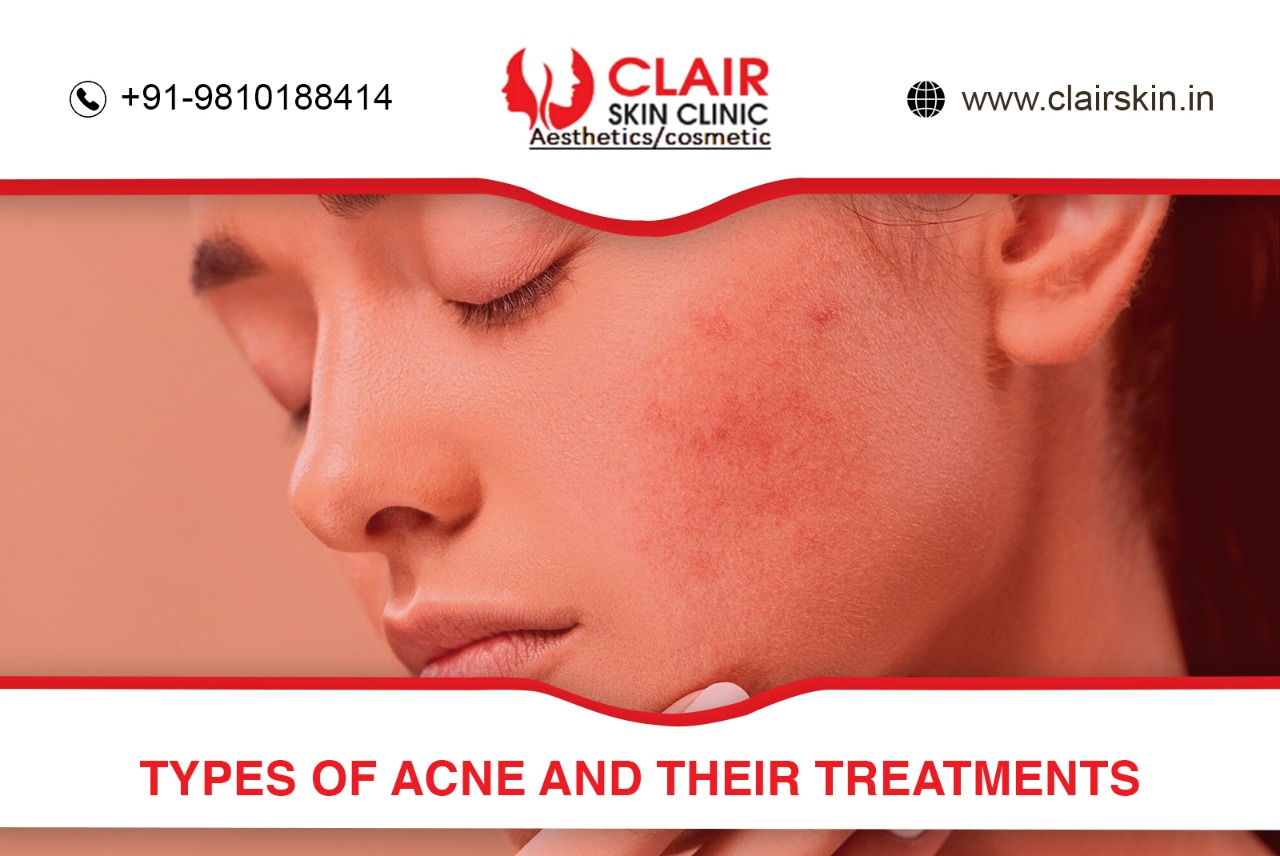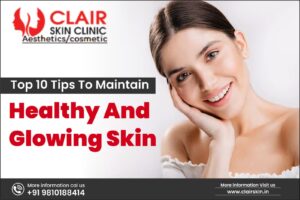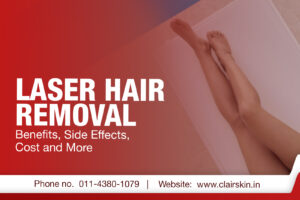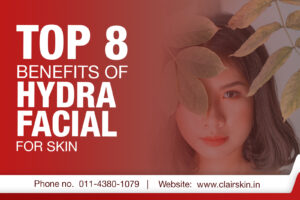Acne is referred to as a condition of the skin when the hair follicles under the skin become clogged by dead skin cells and oil. As a result of this clogging, there are outbreaks of lesions in the form of pimples and zits on the skin. Usually, these outbreaks mostly occur on the face but can also occur on the chest, back, and shoulders.
Acne is common in adolescents and teenagers. In most cases, acne gets subsided on its own without any acne treatment, but in severe cases, treatment becomes necessary. Acne is a commonly used term, but very few are aware of the different types of acne. Here we will delve a bit deeper into the topic and not only understand the acne’s types but also their treatment.
Overview
Acne is a common skin condition caused by clogged hair follicles, where oil and dead skin cells build up, resulting in whiteheads, blackheads, or pimples. While teenagers are most commonly affected, acne can occur at any age. Treatment options are available, but managing acne can be challenging due to its persistence and varying degrees of severity. Let's delve into the types of acne and the treatments available.
Acne scars form after a pimple or acne breakout has healed. These scars are more likely to develop from severe breakouts, such as cysts or nodules. Additionally, picking or scratching at acne can damage the skin and lead to scarring. Let’s dive more into the article to learn about types of acne scars.
Table of Contents
Feel free to skip ahead if one topic catches your eye:
1. Whiteheads
A whitehead refers to the type of acne which forms at the time when oil, dead skin cells, and bacteria get trapped within the pores of the skin. Whiteheads happen to be quite irritating and can even get worse at times.
Causes of Whiteheads
A clear understanding of the causes of whiteheads helps in not only their cure but also prevention in the future. A few of the important causes of whiteheads when the amount of oil or sebum production is increased to clog the pores are as follows.
- Puberty
- Menstruation
- Pregnancy
- Use of contraceptives or birth control pills
- Genetics
Treatment for Whiteheads
Whiteheads are considered as mild types of acne and hence easier to treat. Topical retinoids are commonly used for treating whiteheads. In case of inflammation, the doctors might suggest some oral or topical antibiotics as well.
Also Read : Acne Scar Removal: Types, Causes, And Treatment At Clair Skin Clinic In Delhi
2. Blackheads
Blackheads are small bump-like appearances on the skin that occur as a result of clogged hair follicles. These are referred to as blackheads since their surface appears black or dark. They appear most commonly on the face but can also appear on the neck, chest, back, shoulders, and arms.
Causes of Blackheads
Blackheads occur due to the development of plug or clog in the opening of the skin’s hair follicles. Some factors that increase the chances of causing blackheads are listed below.
- Production of an excessive amount of body oil
- Undergoing hormonal changes during teenage, menstruation, or while having contraceptive pills
- Building up of acne specific bacteria called Propionibacterium on the skin
- Consumption of certain drugs like androgens, lithium, or corticosteroids
- Irritation of skin’s hair follicles when the dead skin cells are not shed regularly
Treatment for Blackheads
Over the counter treatments are the most common acne treatment followed. The treatment procedure includes medications available in the forms of gel, cream, and pad that are directly put on the skin. These medications contain benzoyl peroxide, salicylic acid, and resorcinol that work by eradicating bacteria, drying the excessive amount of oil, and compelling the skin to shed all dead skin cells to ensure no clogging.
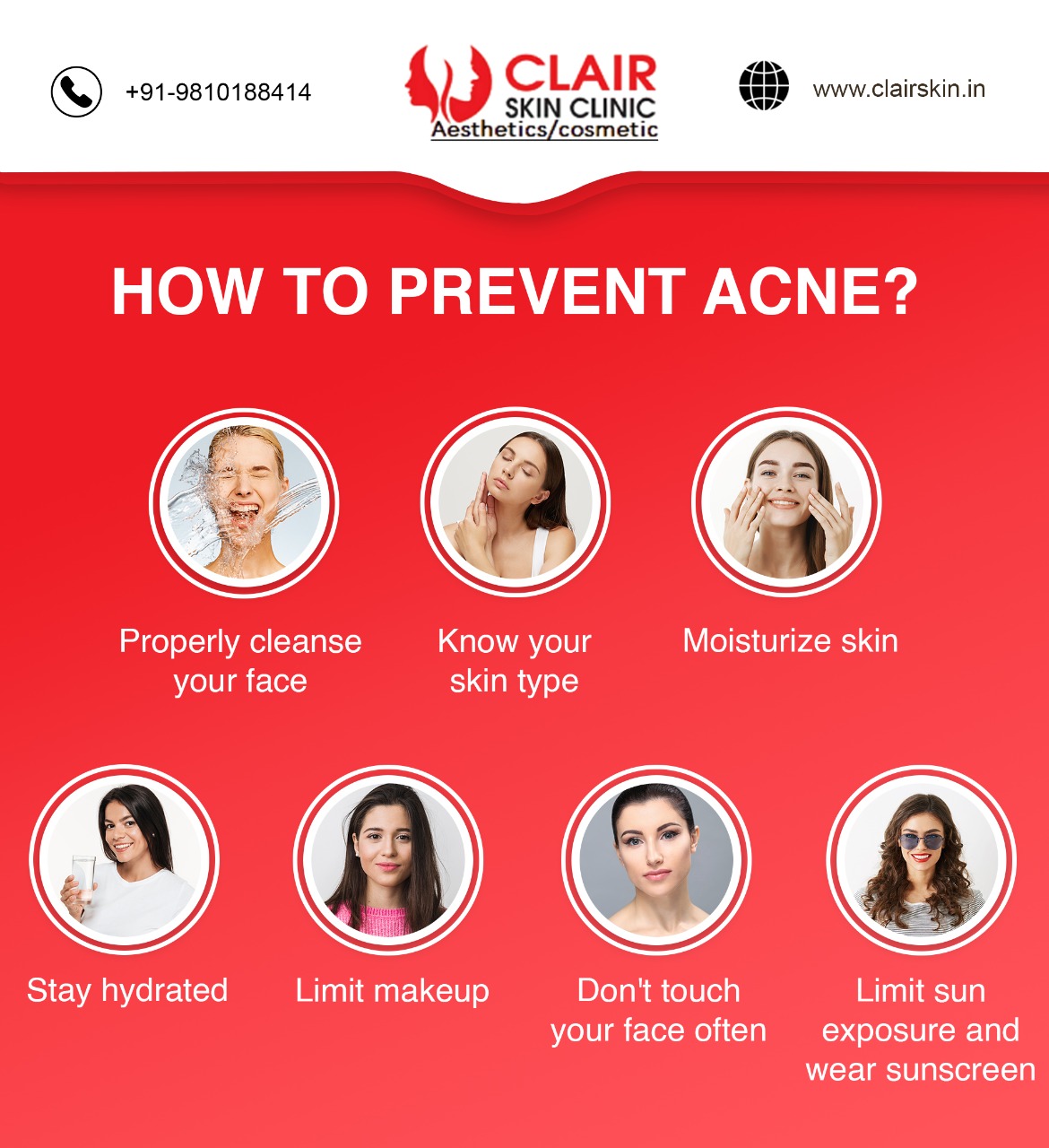
3. Cysts
Cystic acne or cysts are one of the serious types of acne that occur as red and painful breakouts deep in the skin. Pimples occur when a skin pore gets clogged with dead skin cells. When bacteria get trapped too, it causes the area to become swollen and red. Cysts occur when this infection goes deep under the skin, creating a bump full of puss.
Causes of Cysts
The exact causes of cysts are not known, but the hormone androgen plays a significant role in this regard. As a teenager, the levels of androgen go up, causing cysts. Other factors causing cystic acne or cysts are mentioned below.
- Menstruation cycle in women
- Menopause
- Pregnancy
- PCOS or polycystic ovary syndrome
- Use of certain medicines or skin products
- High humidity
Treatment for Cysts
Cystic acne treatment is of immense importance to appropriately deal with this serious type of acne. Hence, visiting a skin specialist in Delhi to get the most effective treatment for cysts or cystic acne is always helpful. Over the counter medicines usually do not work in this regard, and special treatment methods are followed.
- Use of oral antibiotics and Benzoyl peroxide to control bacterial growth and reduce inflammation
- Retinoid is used to unclog the pores and facilitate antibiotics to work effectively.
- Use of spironolactone for reducing excess oil
- Use of steroids that are directly injected into the cysts
4. Nodules
Nodules or nodular acne involves the bacteria known as ‘p. acne’. These bacteria are commonly found on the skin but when trapped in the pores along with oil and dead skin cells, it leads to the formation of nodules under the skin.
Causes of Nodules
Some of the common causes of nodular acne or nodules are as follows.
- The Occurrence of skin infections
- Overproduction of thyroid hormones
- Deficiency of iodine
- Enlargement of lymph node or lymphadenopathy
Treatment for Nodules
Being one of the most serious types of acne, acne treatment for modules should be done with more care. Topical acne medications are directly applied to the nodule as well as for acne scar treatment. Use of antibiotics, benzoyl peroxide, salicylic acid, and retinoids are common for killing the bacteria trapped in the pores, dry out the trapped oil, shed out dead skin, as well as unclog the trapped hair follicles.
Also Read : Does Hydrafacial Work For Acne?
5. Pustules
Pustules appear like small bumps on the skin containing pus. The bumps are usually white with surrounding red skin. Pustules are similar to pimples but might grow quite big.
Causes of Pustules
Pustules or pustular acne occurs due to skin inflammation owing to any allergic reaction to food, poisonous insect bites, or environmental allergens. Pustules clog the skin with dead skin cells and oil resulting in patches of skin.
Treatment for Pustules
Pustules are types of acne that go away normally without treatment if small. But if the bumps are large and consistent, acne treatment is important. Use of over the counter medications, creams, cleansers, and soaps are commonly used for treating small pustules. In more severe cases, topical medications like salicylic acid, peroxide, and sulphur are used.
6. Papules
Papules are very small red bumps devoid of any yellow or white center of pus. If pus is accumulated in a papule, it becomes a pustule. Papules are types of acne that become pustules within some days but can be prevented by getting proper acne treatment in Delhi so that it does not spread further.
Causes of Papules
Some of the important causes of papules are as follows.
- Excessive production of oil
- Trapped bacteria
- Excessive activity of androgens
- Too much stress
- Diet including too much sugar
- Use of certain medications like corticosteroids
Treatment for Papules
Acne treatment for papules starts with salicylic acid or benzoyl peroxide. For inflammatory papules, doctors might use topical medicines like dapsone (Aczone), retinoids including tazarotene (Tazorac), tretinoin (Retin-A), and adapalene (Differin). Some antibiotics are also used for acne spot treatment.
At Clair Skin Clinic, every individual suffering from acne or finding a hard time dealing with the same can be assured of getting the best acne treatment. The clinic has some of the best dermatologists in New Delhi who make sure to provide the affected individuals with the best recommendations and premium quality treatment according to their skin type and concern. Moreover, the dermatologist at the clinic also provides detailed information to prevent acne and follows up with the ideal treatment for acne for the best possible results.
Types of Acne Scars
There are 7 types of acne. Let’s get further into the article to learn the kind of scars they leave.
Depressed Acne Scars
These scars occur when the skin produces too little collagen during the healing process, resulting in an indentation.
Types of Depressed Scars
- Ice Pick Scars: These are the most common type of acne scars, characterized by small but deep pits in the skin.
- Rolling Scars: These scars are wide and shallow, giving the skin a rolling or wavy texture when present in large numbers.
- Boxcar Scars: Round or oval depressions that are wider than ice pick scars but narrower than rolling scars.
Raised Acne Scars
These scars form when the skin produces too much collagen during the healing process. They are more prevalent in individuals with darker skin tones.
Types of Raised Scars
- Hypertrophic Scars: Firm, raised scars that usually develop on the jawline, chest, or back. They often appear 1 to 2 months after the acne clears.
- Keloids: These scars grow larger than the original acne lesion. The first sign is usually thickening skin, which can begin 3 to 12 months after the acne has healed. In some cases, keloids take even longer to form. Wearing a pressure garment can help prevent or reduce the size of a keloid if thickening skin is noticed.
Flat Spots Post-Acne
After an acne breakout clears, flat, pigmented spots may remain. These spots are generally not considered scars. A common type of flat spot is post-inflammatory hyperpigmentation (PIH).
Post-Inflammatory Hyperpigmentation (PIH)
PIH appears as flat spots that can be red, pink, brown, or bluish-gray, depending on your skin tone. While these spots are not scars and tend to fade over time, treatment can expedite their clearance.
Treatment Options For Acne Scars
While there are many over-the-counter treatments for acne scars, achieving the best results often requires a deeper understanding of the skin and the most effective treatments for different types of scars. This is why board-certified dermatologists tailor individualized treatment plans for each patient.
Get Serious To Achieve That Clear Skin
Effective and safe treatment for acne scars starts with a professional consultation. Not everyone needs or wants treatment for their scars, so it’s important to determine if it's right for you. Before making an appointment with a board-certified dermatologist, reflect on these questions:
- Do I often wish my acne scars would disappear?
- Do my scars affect my confidence in dating, job opportunities, career advancement, or academic performance?
- Have I become less social and outgoing since developing acne scars?
If you find yourself agreeing to any of these questions, it might be worthwhile to discuss treatment options with a dermatologist. This consultation can help you explore the best approaches to improve your skin and regain your confidence.
Diagnosing Acne
Doctors diagnose acne by examining the skin for characteristic signs. Sometimes, they may also request a blood test to assess hormone levels.
7 Other Different Types of Acne - Explained
The term “acne” often conjures images of inflamed and red pimples on our faces. It is a complex skin condition that comes in various forms and types. Besides the typical acne vulgaris, there are several other types of acne with their unique characteristics. Listed are the seven other different types of acne you must know.
Subclinical Acne
Subclinical acne refers to superficial acne that’s located just below the skin. It is also known as comedonal acne and is caused by hormonal imbalances, clogged pores, bacteria, etc. Most dermatologists opine that the best way to treat subclinical acne is by maintaining a good hygiene. Washing your face twice daily with a gentle cleanser can be pretty effective. The most effective treatment for subclinical acne is to use retinoid creams.
Fungal Acne
It is another major type of acne that can severely affect your appearance. Fungal acne causes the hair follicles to get inflamed. It can occur anywhere on your body and is caused by tight clothing and sweating. You might be dealing with fungal acne if you have tried multiple treatments with no results. One of the most effective treatments for fungal acne is cryotherapy.
Hormonal Acne
Hormonal acne, also known as adult acne, affects adults between 25 and 50. Acne causes bumps on your chest, shoulders, face, etc. It is typically associated with puberty but can affect adults of any age. It is also a direct result of excess sebum in oil glands. Hormonal acne affects men and women, but the majority of cases occur in women and pregnant women.
During puberty, hormonal acne appears in your T-Zone, which includes the chin, forehead, and nose. Hormonal acne typically forms on your face’s lower part. Some food items, like antioxidants, may help prevent acne. Limiting red meat and refined carbs can help you get respite from hormonal acne. If you have hormonal acne, using non comedogenic products can help reduce clogged pores.
Pyoderma Faciale
Pyoderma Faciale is an uncommon type of facial acne that occurs in adult women. Unlike traditional acne, it doesn’t involve the breakout of whiteheads or blackheads. Pyoderma Faciale leads to the formation of large and inflammatory nodules and ulcers. The exact cause of Pyoderma Faciale is unknown. However, hormonal imbalances are believed to be the main reason behind their occurrence. If you have Pyoderma Faciale, your doctor will prescribe mid to high-potency steroids twice daily.
Acne Rosacea
Acne Rosacea is not your typical acne. It is usually characterised by visible blood vessels, redness of the skin, and puss-filled bumps on the skin. Unlike other acne, rosacea typically affects individuals aged 30. The exact cause of rosacea is still being researched.
But, dermatologists believe that a combination of environmental and genetic factors are responsible for acne rosacea. Your dermatologist will conduct a thorough exam of your signs and symptoms to diagnose rosacea.
Treatment of rosacea varies based on the symptoms of each person. Your doctor may prescribe several types of oral and topical medicines to treat bumps and skin imperfections caused by rosacea. Your doctor can also use lasers to eliminate the visible blood vessels from the skin.
Acne Fulminans
Acne fulminans, also known as acne maligna, is a rare skin disorder. It refers to the sudden and severe onset of acne that usually affects adult males. Acne fulminans can lead to severe scarring and require prompt medical intervention.
The most effective way to treat this type of acne is by administering oral steroids and antibiotics. Your dermatologist can also prescribe anti-inflammatory medications like salicylates and high doses of antibiotics. The main reason behind acne fulminans is hormonal imbalance.
Back Acne
Most of us believe that the face is a common site for acne. But acne can affect other areas of your body too. Acne can occur in any area of your body that secretes sebum. Your shoulders, back, chest, etc., are some areas where acne can appear.
Like other acne, back acne is the outcome of clogged pores. You can take various self-care measures to arrest the growth of back acne. However, if these measures fail to yield any positive result, seeing a board-certified dermatologist is the best option.
Acne Conglobata
Acne Conglobata is a rare but severe type of nodulocystic acne. Acne Conglobata can often lead to extensive scarring. It is usually characterised by abscesses and nodules on the chest and the back. It is a condition that typically affects males.
Due to the severity of this acne, you should consult with a reputed dermatologist. Over-the-counter acne treatments fail to produce feasible results in treating Acne Conglobata. Usually, your doctor will recommend topical and oral medications to treat this type of acne. Oral steroids are the most effective treatment option to reduce scarring.
For effective self-care, it is crucial to identify the type of acne you have. Ensure that you seek the proper and timely treatment to minimise scarring.
Acne Treatment Options
There are multiple acne treatments, including:
- Cleansers or face washes
- Topical creams
- Ointments
- Oral medications
Pharmacists can suggest over-the-counter treatments for mild acne. For more severe cases, or if initial treatments fail, doctors might prescribe:
- Antibiotics
- Anti-androgen medications like birth control pills
- Retinoids
Acne treatment requires patience, often taking 2 to 3 months to show noticeable improvement. Consistency is key, so keep following the treatment plan even if results aren’t immediate. If there’s no progress, consult your pharmacist or doctor about alternative treatments.
Skin Cleansing
Proper skin cleansing is crucial in treating and preventing acne. Use a gentle, soap-free, pH-balanced cleanser and wash your face with warm water twice daily. Avoid excessive washing, as it can aggravate acne. If your skin remains oily after cleansing, seek advice from your pharmacist.
Additional Acne Treatments
For mild acne, additional treatments include:
- Light microdermabrasion
- Chemical peels
- Light diathermy
These treatments may need to be performed regularly and are not suitable for severe acne.
Natural Acne Remedies
Certain natural ingredients can help manage acne, such as:
- Alpha hydroxy acid (fruit acid)
- Azelaic acid
These remedies can sometimes irritate the skin or interact with other medications. Always discuss the use of natural treatments with your doctor or pharmacist before starting them.
Takeaway
Acne and its subsequent scarring can significantly impact one's self-esteem and quality of life. While effective treatments are available, they often require patience and consistency. Consulting with a board-certified dermatologist can provide a personalized treatment plan tailored to individual needs.
By understanding the types of acne and scars, and exploring various treatment options—from over-the-counter products to professional procedures—individuals can find the most suitable methods to achieve clearer skin. Regular skin care, proper cleansing, and medical guidance are essential steps toward managing acne and improving skin health. Taking proactive measures can lead to noticeable improvements and renewed confidence.
References
1^ Whiteheads, www.healthline.com, 02/10/2021
2^ Blackheads, www.healthline.com, 02/10/2021
3^ Cysts, www.webmd.com, 02/10/2021
4^ Cysts, www.medicalnewstoday.com, 02/10/2021
5^ Nodules, www.healthline.com, 02/10/2021
6^ Pustules, www.healthline.com, 02/10/2021
7^ Papules, www.healthline.com, 02/10/2021

